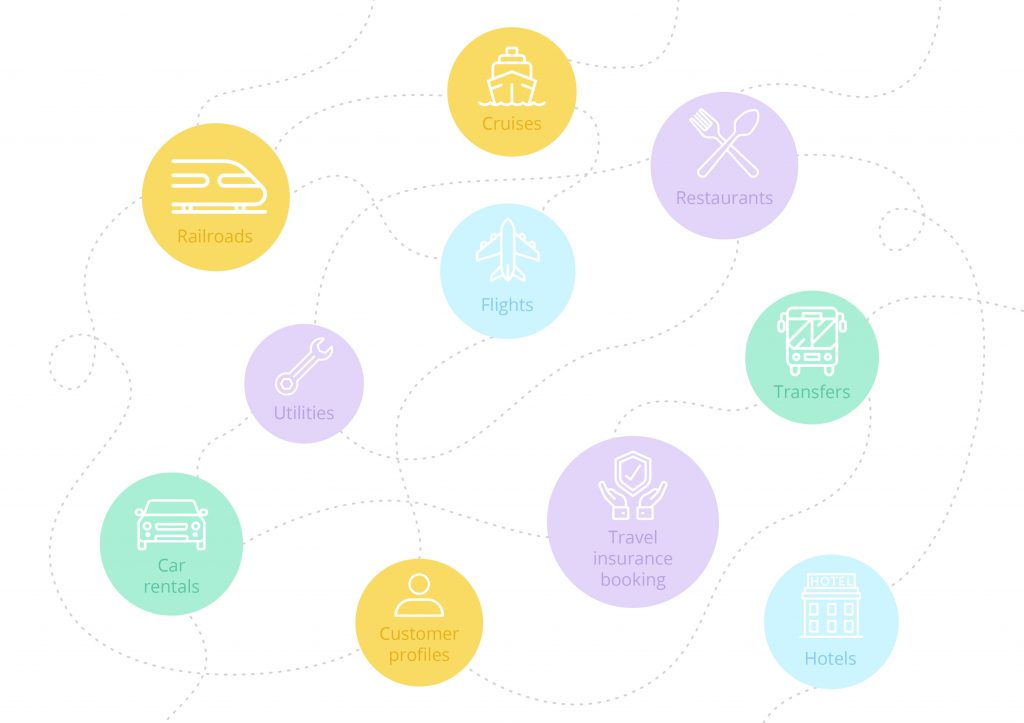An Overview of Travel Booking APIs for Travel and Tourism Providers

Like most industries nowadays, the tourism and travel industry is being transformed by Internet technologies. Modern travel websites and applications allow for booking flights, hotels, cruises, and other services almost instantaneously. ‘All-in-one-place’ online travel platforms have reshaped the user experiences, unifying and simplifying them. According to Statista, revenue in the segment totals $434B in 2019 and is expected to show an annual growth rate of 6.2% over the next four years.
The current shift towards travelers booking online started with the creation of Internet booking engines. We had mentioned online booking systems in the context of travel agency software, but they certainly deserve more attention.
This article starts with the methods of integration of a booking system into a travel business’ website. An emphasis is made on connection via a travel booking API (application programming interface). The second chapter provides an overview of popular travel industry APIs.
How to Integrate an Online Booking System without Custom Code Development
There are four ways to integrate an online booking system into a website without writing original code. The choice of the optimal method depends mainly on your content management system (CMS) and budget.
1. Link to an external website
The simplest method is to link the travel business website to an external website. It isn’t a real integration, but it’s cheap and easy to implement. You just have to create a link that will send site visitors to another destination. That’s something most site owners don’t want to do, though. The external website, with a different branding, could be slow or offer inadequate user experience. Users behavior analysis and strategizing will suffer as well.
2. Embed an inline frame (iframe)
Iframe allows embedding an external website into your site. Unlike external linking, iframe integration doesn’t send visitors away. To execute iframe integration, you need to copy and paste some ready-made code into your website.
Most websites that allow embedding provide the opportunity for free. The cons of the iframe are that you have no control over how it is displayed. With responsive sites, iframe often doesn’t display correctly in a mobile context, unless the external booking system is mobile as well. Iframes won’t let you track your users’ activity and implement your branding either.
If your website is made with drag-and-drop builders, external links or iframes are the only options.
3. Install a plugin
An online appointment scheduling plugin is excellent for small businesses. The popular CMS platforms like Drupal, Joomla, or WordPress have quality plugins. Website owners can use them for free or get a yearly license for the same price as hiring a programmer for two hours. If your website was built on WordPress, well-developed plugins might provide the best value for money.
Usually, it takes a few clicks to get the plugins up and running. They are also typically optimized for different devices so that online booking works equally well on a computer or smartphone. Just make sure the plugin is up-to-date. If you install too many plugins provided by different developers, they can be conflicting and slowing down your website.
4. Connect via a travel booking API
APIs can be squeezed into one word — connectivity. They connect data streams and functionalities between different software products. APIs allow one company to access the products of another company in a legitimate way, for example, bridging the gap of the data flow across the connected supply chain.
Practically speaking, a hotel business can connect its room reservation system with local car rental providers. Customers can rent a car straight from the website, making the booking process hassle-free and fast. Smart city builders use APIs to create travel guides and other apps to help tourists and others find their way around town and locate the best restaurants, museums, sightseeing attractions, and so on. Everything seems to be possible as travel industry players are increasingly willing to share data.
Uber is a travel API pioneer. In 2014, the company allowed Hyatt hotels, OpenTable, Starbucks, United Airlines, and several other third parties to add the “request a ride” function to their applications. The integration enabled tourists to book Uber rides without switching apps, using just one platform.
Most often, it’s CMS-driven websites that can integrate APIs. Their most significant advantages are the excellent user experience and control of the user interface. APIs and XML (Extensible Markup Language) quickly provide users with accurate information, e.g., on room availability, pricing, etc. APIs also allow tracking travel data and user behavior, as well as communication in both directions: your website can both push and pull data instead of merely displaying it.
APIs provide the best way to integrate an online booking system without developing custom code. It’s great news that the market abounds in travel APIs for various needs and budgets.
Travel Booking APIs Are There to Connect
(We couldn’t possibly list all of the best APIs on the market in a short article like this, or without looking biased. Instead, we are presenting a random cross-section that gives an idea of what is available).
Amadeus APIs
Amadeus APIs relate to GDS (global distribution system) capabilities. The APIs are delivered either as self-service or enterprise sets:
Self-Service APIs
Self-service APIs have replaced an old travel booking API — Innovation Sandbox — and are designed not only for prototyping purposes but also for commercial use. These APIs facilitate flights-hotels search, including the search for the cheapest dates, lowest fares, and most booked destinations.
Amadeus Self-service APIs use REST/JSON standards. All available APIs can be used for testing purposes with these standards for free with 2,000 – 10,000 monthly requests, depending on a particular service. The price of these APIs in production would be $0.0028 – $0.034 (€0.0025 – €0.030).
Enterprise APIs
This is the main set that covers nine distribution types:
- Railroads
- Flights
- Hotels
- Car rentals
- Transfers
- Cruises
- Travel insurance booking
- Customer profiles
- Utilities
Each type contains multiple APIs. Some perform an informative function like locating the lowest fares or flexible-schedule fares. Others are tailor-made for ticket booking, providing a large room for adaptivity to configure the set of services for the client’s product. Enterprise APIs come in all sorts of REST/JSON and SOAP/XML formats. You have to contact Amadeus directly to inquire about pricing and accessing the APIs. There will also be special requirements to access their service.

Google Flights API
Google Flights is an online flight search and booking engine which helps purchase airline tickets through third-party suppliers. Customers can compare options and prices, and quickly locate spots where they can buy their tickets. This platform is available in 90 countries, but it’s primarily intended for enterprise partners.
Google Flights is free up to 50 queries a day. After this quota is exceeded, a usage fee of $0.02 is applied per query.
Kayak API
Booking Holdings operates Kayak API, including travel fare aggregator and large travel search engine. It’s free of charge and accessible in all countries. Kayak provides comprehensive documentation and other resources for easier implementation of the API into web or mobile applications.
Sabre APIs
The functions of Sabre APIs are similar to the set provided by Amadeus. Sabre APIs can be divided into eight groups:
- Ground transportation
- Airlines
- Hotels
- Cruises
- Profiles
- Trip management
- Session management
- Utility
Currently, the system doesn’t provide insurance and airport transfers options. Amadeus can replace them if necessary.
Skyscanner API
Skyscanner invites its API users to enroll in an affiliate program. If you go through their verification process, you can get a set of APIs for free. Once a certain revenue threshold is reached, you may arrange to have a commission based on your traffic and market promotional strategies. It is represented in two main versions:
- Browse Flight Prices. This set sends cached prices for a variety of origin-destination and time-frame queries. This means a developer can set up a flexible flight search option, which also allows looking for the best hotel booking prices. The disadvantage is the cached doesn’t get a frequent update for less familiar route and date combinations. If the price changes, sometimes users won’t be able to see updated travel data.
- Live Flight Prices. The live flight prices function launches API returns of fares precisely for any given moment. However, you must input the time and route exactly to retrieve flight prices (a handy feature when comparing pricing for specific dates and routes).
Developers can easily integrate their application to Skyscanner platform to get all the available flight data through Skyscanner API. It’s accessible in all countries.
TripAdvisor API
TripAdvisor is the largest site for booking trips. They have up to 702 million reviews and feedback covering a wide range of global travel listings. Developers can access current rating content and select travel sites.
The TripAdvisor API content is available only to licensed travel partners. It can be accessed from 30 countries and is free of charge.
Conclusion

Experts affirm that the travel industry will keep on growing in years to come. Travel companies are more willing to open up their APIs, allowing developers to integrate applications into the infrastructure. As a result, both parties benefit, and the customers can book flights, hotel rooms, tours, and car rides much faster and more conveniently on all-in-one-place platforms.
As the world and tourism, travel, and hospitality industries become more connected, it’s crucial to be working with the best up-to-date APIs sourcing the right data and delivering the greatest value to your customers.
However efficient a travel API may be, don’t discard custom development altogether. A piece of code that is a part of your website’s source code ensures a seamless integration of an online booking system. It minimizes the issues of conflicting or bloated code and gives you control over absolutely everything on your business website.
If you’re not sure which integration method is right for your website, or need assistance with building a unique solution for your business — don’t hesitate to contact Alternative-spaces! Our experts are here to help.
Content created by our partner, Onix-systems.
 Home
Home